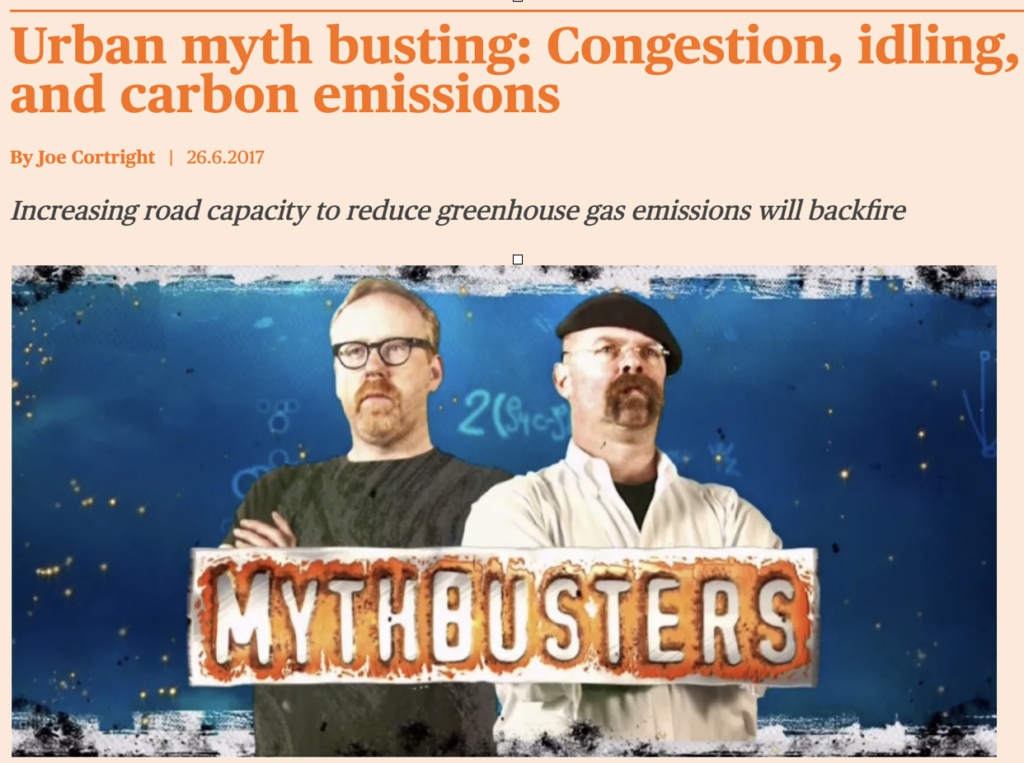What City Observatory did this week
Myth-busting: Idling and greenhouse gas emissions. Highway boosters are fond of claiming that they can help fight climate change by widening highways so that cars don’t have to spend so much time idling. It’s a comforting illusion to think that helping you drive faster is the solution to climate change. But as careful research shows, widening roadways to reduce congestion simply backfires, and leads to more driving, and more emissions.
This particular myth was busted by research from Alex Bigazzi and Miguel Figliozzi of Portland State University. They showed that induced demand means that faster roadways generate more vehicle miles of travel (and more carbon emissions), and that metro areas with higher travel speeds and less vehicle delay have higher rates of greenhouse gas emissions than other metro areas.
Must Read
Krugman on Congestion Pricing: An Act of vehicular NIMBYism. Economist Paul Krugman weighs in on New Jersey’s lawsuit against congestion pricing in Manhattan. Congestion pricing makes sense on both efficiency and equity grounds. As Krugman points out, each additional auto trip to Manhattan likely imposes costs of $100 (or more) on travelers and residents. The proposed fee will likely reduce traffic and lower the burden of those costs. But some auto commuters, especially from New Jersey will pay more. That’s where Krugman points out the equity issue:
What’s really striking is how few people stand to benefit from New Jersey’s attempt to block or delay congestion charges. Fewer than 60,000 New Jersey residents, out of a state labor force of almost five million, commute into New York City by car. They are also, as it happens, relatively affluent, with a median annual income of more than $100,000, relatively well able to handle the extra cost. For this, New Jersey is trying to sabotage crucial policy in a neighboring state?
New Jersey politicians are sticking up for a relative handful car commuters, who are outnumbered by the several hundred thousand New Jersey residents who commute via transit to New York. They stand to gain handsomely from much improved travel times when pricing unclogs streets and throughways.
Why congestion pricing is good for cities. At Planetizen, Michael Lewyn takes on claims made by columnist and economist Tyler Cowen that Manhattan’s proposed congestion pricing would somehow be bad for the city’s economy and health. Cowen reasons that the congestion charge will function as a barrier to entry to the city, discouraging people for traveling there and reducing activity, spending, and jobs. But as Lewyn argues, those cities that catered most to the car were the one’s most devastated by disinvestment and sprawl; places like New York that avoided car dependence have seen less decline, and more resurgence.
The argument rests on an assumption that a city is most appealing when automobile commuting is easy. But this assumption seems inconsistent with historical reality. . . . a “drivable” city is not necessarily a prosperous one. So if making cities like Manhattan easier to drive through doesn’t make them more appealing, it logically follows that making them harder to drive through won’t make them less appealing.
While the congestion charge may make the city less attractive to cars, it iws likely to make it more attractive to people, and easier to access and travel through for the people who value being there. Ironically, Cowen’s argument mimics the early and now long forgotten arguments against parking meters in cities. Charging people for urban space causes them to use in more efficiently, and tends to allocate it to users who value it highly (and who contribute greatly to the local economy).
New Knowledge
Traffic calming and traffic evaporation. One of the chief concerns with road diets, low traffic neighborhoods and other systems of bike/pedestrian improvements is that such measures will divert and concentrate traffic on other nearby streets. A new literature review from Germany summarizes the results of evaluations of such projects in several European cities and concludes that, contrary to these oft-raised concerns, traffic largely evaporates, rather than being displaced.
The authors conclude:
Overall, the empirical findings from Germany and abroad invalidate the fears that consistent traffic calming measures will merely shift the problem to the adjacent road network. On the contrary: Almost all surveys confirm the phenomenon of “traffic evaporation”– the volume of traffic does not just flow away one-to-one like a liquid elsewhere, but is reduced as a whole.
The authors report that studies show that traffic tends to decline in extensive traffic calming projects between 15 and 28 percent, within entire inner cities by between 25 and 69 percent, in the area surrounding individual redesigned streets by between 4 and 52 percent.
The effect can be explained by a change in traffic behavior: the more attractive footpaths and cycle paths are, the more people use them. Although the measurements certainly show displacement effects in adjoining streets, these are usually moderate
Uta Bauer, Sonja Bettge & Thoams Stein, Traffic calming: discharge instead of collapse! Measures and their effects in German and European cities. German Institute for Urban Studies (Difu), Berlin, 2023. (Text in German). (https://www.sciencedirect.com/science/article/abs/pii/S0965856421000872#!). (Quotations translated from German via Google Translate and abridged)

